Another Lost Film – The Battle of Gettysburg
Posted By Norman Gasbarro on March 10, 2013
In a 1996 book, Lost Films: Important Movies That Have Disappeared, Frank Thompson, describes the preservation problem of old films, particularly those made during the silent film era (about 1893-1930) – films that were made on nitrocellulose stock, which, if not stored in the most perfect conditions, is known to deteriorate rapidly into a “bubbling goo, then dry to a mass of un-projectable material.” In a comprehensive introduction, Thompson takes the reader through film history and explains the recent efforts that have been made to preserve and restore many of the films of the past, but sadly notes that perhaps as many as 90 percent of these old films are forever lost. Each of the chapters of the book examines one of 27 classic films that are believed to no longer exist – including a film that was released in 1913, “The Battle of Gettysburg,” which was produced by the New York Motion Picture Picture Company in time for the 50th Anniversary of the Battle. The director of this film was Thomas H. Ince, but beyond the certainty of that, such important information as the actual cast list, needs to be further researched and confirmed.
Using resources such as the files of the New York Motion Picture Company, print periodicals such as Moving Picture World and Motography, some surviving stock footage that was used in other films, and photos made for publicity purposes, Thompson attempts to re-create “The Battle of Gettysburg” and tell something of its impact on audiences of the time. The chapter gives a synopsis of the story and concludes with a report on it first showing on Sunday, 1 June 1913, at the New York Grand Opera House, where the audience “went wild as the stirring scenes and exciting incidents of the of the memorable battle were once more enacted before their very eyes.” (page 26).
Despite the fact that this film is probably lost forever (unless a print can be located somewhere where it has been kept in optimum conditions – and then carefully restored and preserved), there are many things that are known about the film – including a synopsis of it, which Thompson provides in the chapter. Essentially, the film reproduced the battle, day by day, and was said to be “historically accurate in every detail.” Interwoven throughout the film, which was five reels in length, was a love story and at least two appearances by Abraham Lincoln and one by Gen. Robert E. Lee. Although depicting an area filled with “lush greenery” (the Pennsylvania countryside), the film was shot in the “scrub-covered hills” near Malibu, California. There was literally a “cast of thousands,” and it took about four months to produce.
One of the puzzling aspects of this film – and something that remains to be discovered and confirmed – is the name of the actor who played Abraham Lincoln. One cast list names Willard Mack while Thompson notes (in a footnote) that the director’s brother, Ralph Ince, was known for the portrayal of Lincoln in another film which had been released a year earlier. The IMDb database claims that Charles Edler was cast as Lincoln.
Two still photos of scenes including Abraham Lincoln, a small portion of which are reproduced here in low resolution, are found on pages 20 and 24 of Lost Films. The first shows a somber Lincoln at the White House, reading reports from advisers as the battle progresses.
The second photo shows Lincoln at the Gettysburg battlefield as he is giving the Gettysburg Address.
Advertisements for the film, which usually appeared in local newspapers prior to screenings, and “reviews of the film,” sometimes written by studio publicists, were not included in the Thompson book. Some of them are reproduced below as they appeared in three different Pennsylvania newspapers.
In Philadelphia, the film was shown at the Allegheny Theatre.
ALLEGHENY – Beginning with tomorrow’s matinee a spectacular reproduction of the “Battle of Gettysburg” will be shown on the screen at the Allegheny Theatre. An absorbing dramatic story leads up to the eve of the conflict. The picture is replete with scenes of exploding cannon, bursting shells, thrilling cavalry charges, hand-to-hand encounters and other deeds of valor. The battle will be reproduced three times daily, one performance in the afternoon and two at night. [from Philadelphia Inquirer, 8 June 1913].
Thrilling Picture at Allegheny. “The Battle of Gettysburg,” a gripping photoplay, thrilled large audiences at the Allegheny Theatre yesterday. Almost 15,000 actors appeared during the course of the realistic reproduction. The picture was replete with scenes of exploding cannon, bursting shells, cavalry charges, hand-to-hand encounters and other deeds of valor. [from Philadelphia Inquirer, 10 June 1913].
Later, it was shown at Willow Grove Park:
Included in the Willow Grove Park’s program was the last week of Victor Herbert’s Orchestra and at the Moving Pictures Theatre, the first production of 50th Anniversary of the Battle of Gettysburg, Saturday and Sunday. [from Philadelphia Inquirer, 13 July 1913].
In Harrisburg, the film was screened at the Victoria Theatre:
Victoria Theatre. Monday has been dedicated as G.A.R. day as the “Battle of Gettysburg” in five reels will be shown. This film is the most expensive picture which ever came to this city. Hundres of men were employed to produce this picture. You see all the principal battles that took place and the third day’s battle is produced in its entirety…. [from Harrisburg Patriot, 5 July 1913].
 Victoria Theater To-day, by Special Request – The Battle of Gettysburg – 5 Acts – $75,000 Production. Admission 5 cents. [from Harrisburg Patriot, 13 October 1913].
Victoria Theater To-day, by Special Request – The Battle of Gettysburg – 5 Acts – $75,000 Production. Admission 5 cents. [from Harrisburg Patriot, 13 October 1913].
VICTORIA THEATRE. The management of this theatre has had many requests of late to get the famous war picture again entitled “The Battle of Gettysburg” in five acts. It will be shown again today. You see the late war from the beginning to end. The third day’s battle is a wonderful piece of motion picture work. It cost many thousands of dollars to produce this film and every soldier and son and daughter of a soldier should see this picture today. [from Harrisburg Patriot, 13 October 1913].
AT THE STAR AND UNIQUE. The Battle of Gettysburg, a thrilling five reel war drama, will be shown at the Star and Unique Theatres Friday and Saturday. The picture was made at enormous expense, requiring four months for its completion and the employment of thousands of soldiers. The plot the picture is based on goes back to 1863. in June of that year Stonewall Jackson had been killed and General Grant was besieging Vicksburg. To relieve the South, and if possible capture Washington, Lee made a fighting attack on the North. He was met by the Federal forces at Gettysburg, Pa., and here, July 1, 2 and 3, 1863, ensued a fierce battle in which thousands of lives were sacrificed in the sensational cavalry and infantry charges and hand-to-hand combats. The opposing artillery mowed the struggling men. The charge of Gen. Pickett with 4,900 men was noted as the most thrilling incident of the war. The Union army at this battle numbered 77,000 while the Confederate forces totaled 59,000 men. [from Wilkes Barre Times Leader, 28 May 1913].
THE BATTLE OF GETTYSBURG. In Five Parts. By Request Return Engagement. UNIQUE & STAR. Public Square. E. Market St. JULY 4th.
During this the 50th anniversary of the three days’ battle at Gettysburg, July 1, 2, 3, 1863, the veterans numbering thousands which is a small number compared to the vast army in that memorable battle, are now encamped on the Battlefield. It is fitting that this thrilling military picture which we have secured at a great expense, be shown to you on this day.
ADMISSION: Adults, 15 cents. Children, 10 cents. [from Wilkes Barre Times Leader, 2 July 1913].
—————————–
A previous post, The Battle Cry of Peace, told of another lost, silent film that featured Abraham Lincoln – portrayed by William J. Ferguson, a silent film actor who was actually a witness at the Lincoln assassination.
News clippings are from the on-line services of the Free Library of Philadelphia. This is the 78th post in an on-going series of blog posts on the Battle of Gettysburg.
 ;
;

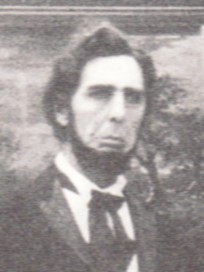
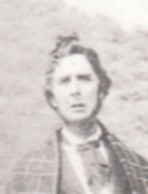

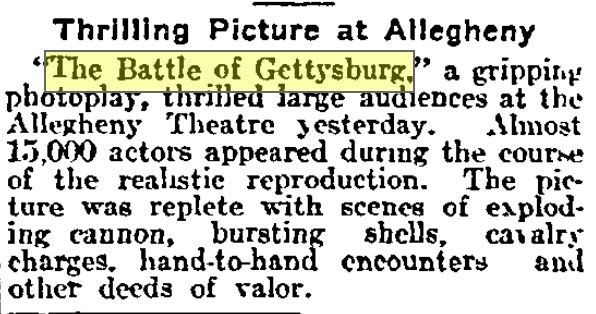
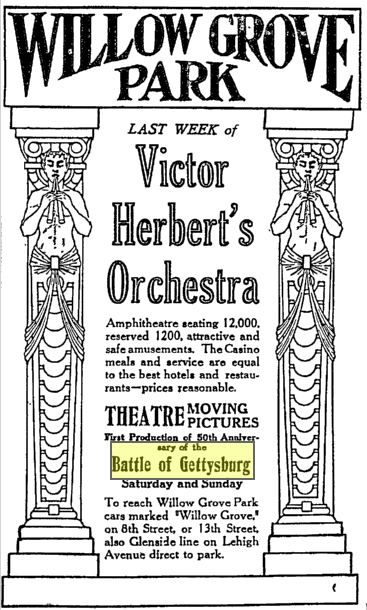
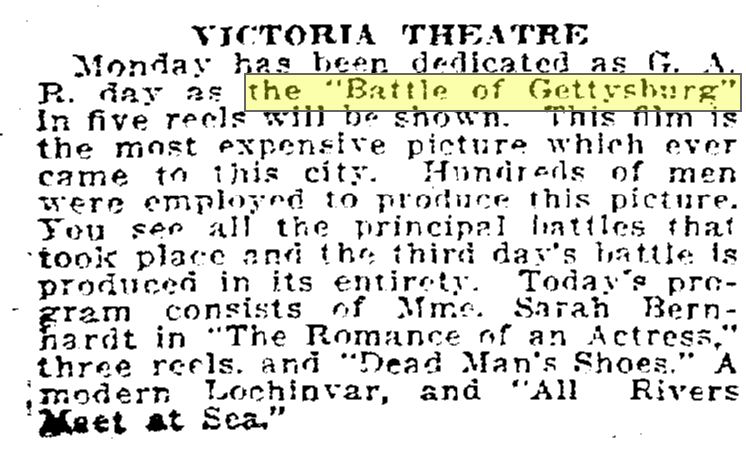
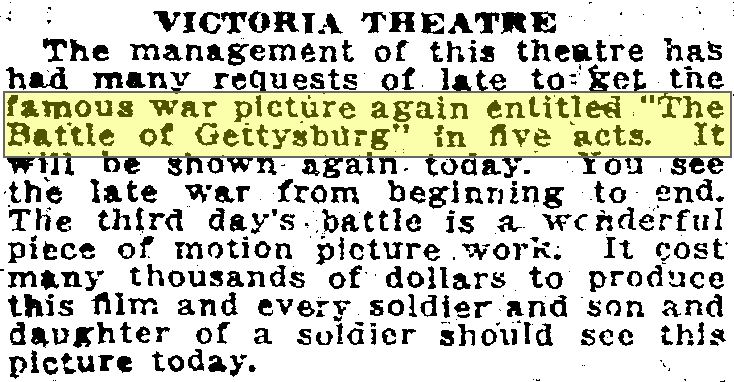
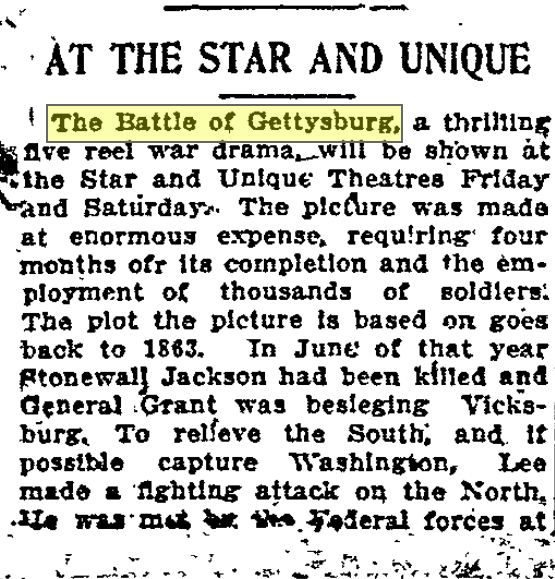
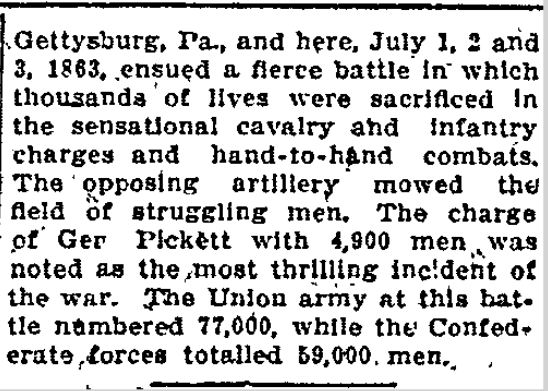



I am interested in knowing what in practice remains of this film. The sixty seconds or so I have seen are desperately poor quality. It is known that footage was used (and can be fairly readily identified) in Keystone’s Cohen Saves the Flag but is marred inevitably by the superimposed antics of Cohen. However I asume that the clips that appear in another Keystone film Chaplin’s A Film Johnnie are also from this film and these are relatively high quality reproductions. It is certainly not a Keystone film that is shown and Sennett, having used clips from “Gettysburg” had reason enough to provide a quid pro quo piece of advertisement for Ince. The reactions of the audience (one of Chaplin’s famous crying scenes) would also seem to reflect (albeit parody) the audience-reactions to Ince’s film as reported in the press. Is anyone able to confimr that these are clips from Ince’s film?
Apparently this film was shown in the small town of Walnut, IL in December 1914.
“On Saturday night December 12th, inst., will be shown the Great Five Reel picture of the Battle of Gettysburg, one of the greatest war pictures ever shown, as this feature was taken on the old Battle Field and more than 5,000 people including soldiers were used in making this picture. Don’t miss this opportunity if you want to know just how this, one of the great battles of the world was fought. One comic besides. Prices 10 and 20 cents.” Walnut Leader, December 11, 1914.